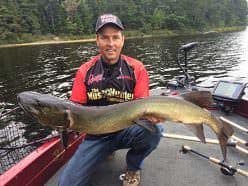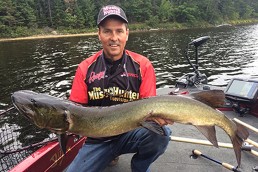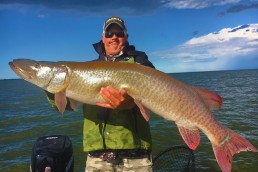Three Keys to Your Personal Best Muskie in 2016
SHARE THIS POST
What was your largest muskie in 2015? Did you meet your muskie fishing goals? As muskie anglers, we are all on a quest to catch the biggest. It’s not about numbers, unless of course it’s a bunch of big ones. That’s what makes muskie fishing different from fishing for other species.
If you want to catch bigger muskies in 2016 and are on a quest for your personal best, there are many things you can focus on during the frozen-water period that can pay big dividends come summer. There are multiple things that can help, but three areas to focus on are research, inventory and education. The amount of effort you put in directly impacts your results.
Do you have a lake X? By lake X I mean a lake, river or reservoir you are on where few others are muskie fishing. Maybe you haven’t fished this lake, but have heard about it and plan to fish it in 2016.
If you have new water on your radar screen now is the time to research the lake. Start by investigating the records of the local Department of Natural Resources, making some phone calls or sending emails. It’s important to know information like stocking records to predict strong year classes of muskies or to anticipate when a population may be realistically fishable. Also, remember that much of a muskie’s lifetime revolves around spawning areas, so it’s imperative to know where the muskies spawn. This will help with both spring and fall muskie locations.
Another research question is when are the big muskies most susceptible? Typically, there is a week or two every year when more big muskies tend to get caught on a particular body of water. That’s when you need to be there. Look at online photos from resorts or guides and note the date when the fish were caught. Checking multiple sources allows you to put together this puzzle. Believe me, determining this window of opportunity can be the single most important factor in putting success in your favor. If you are attending muskie sport shows, be sure and check the dates of any photos you may see. While looking at photos, be sure to make a mental note of sky conditions. Do most of the muskies come from sunny or cloudy conditions? Also, you might even see a lure or two lying on the front deck, and that might provide some further clues.
Are you enjoying this post?
You can be among the first to get the latest info on where to go, what to use and how to use it!
One last thing to consider when researching is to take advantage of social media. YouTube and Facebook can be valuable tools to view photos and videos from the water you are researching. This background information can take hours, but it is fascinating. It’s a great way to really learn everything from where you should stay, launch your boat, and, ultimately where to fish and what lures to use. You can gain a tremendous advantage and almost feel you have been to the water before you even get there.
Once you have done your research and have a better understanding of the type of fishing on lake X, it’s time to take an inventory of your equipment.

It could be you need more of a particular lure and/or color. For example, based upon research, rather than fishing Cowgirls, maybe you’ll need smaller Showgirls and to fish them faster. So, you might need more Showgirls in multiple colors. Likewise, review your rod and reel selection. Again, you might need a medium-heavy action Shimano Compre rod rather than an extra heavy model to obtain maximum casting distance and to feel the vibration of the smaller blades. If you are going to need to fish fast, you’ll need to revisit your reel inventory and maybe get a high-speed Shimano reel to make life easier. My point is that once you do your research, you should take the time to check out your equipment and make sure you have everything you need for the upcoming season. Finally, note what lure(s) you will need. Your research will give you a general idea and you can have a better sense of what you might need while shopping at sport shows this winter.
The final piece of your wintertime muskie agenda is education. We all have our strengths and there’s no need to work on those, but it’s those weaker areas that we may have previously avoided that we should try and tackle. For example, if you don’t have a lot of confidence casting soft plastics, this winter is the time to attend seminars and talk with muskie experts that spend hours fishing these lures. A simple conversation with a guide can really help you better understand or answer your questions that can give you more confidence in using these lures. Even if you don’t think you’ll be fishing a particular lure on lake X, it’s always good to broaden your horizons, as you never know when a new technique will help. If you can catch a couple muskies next year on a new technique, you might gain enough confidence to use it more and better understand how to work it into your repertoire.
Every new muskie season is exciting, as we dream of what will be. Take the time to research, inventory and educate yourself this winter and you’ll take your catches to another level. My motto has always been, “fish hard and fish smart,” and these wintertime activities build the foundation of fishing smart.
MWO
SHARE THIS POST
Did you enjoy this post?
You can be among the first to get the latest info on where to go, what to use and how to use it!
Jim Saric
Jim Saric is a Legendary Angler in the Freshwater Fishing Hall of Fame, the host and executive producer of The Musky Hunter television series, editor at large of Musky Hunter magazine, a seven-time muskie tournament winner, and a contributing writer for numerous other publications.



